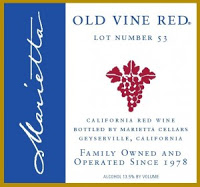 As I grew up around the winery, I think most people expect me to know more than I do about wine — to have an encyclopedic knowledge of wineries, vintage years, soil types — but I don’t. I have a very practical knowledge of wine, mainly acquired from listening to my dad. Luke goes to classes. I have been to one. There was a Powerpoint presentation about French regions. Since then, I have focused my learning on thoughtful wine consumption – understanding why I like our wines, and what other wines I might also like.
As I grew up around the winery, I think most people expect me to know more than I do about wine — to have an encyclopedic knowledge of wineries, vintage years, soil types — but I don’t. I have a very practical knowledge of wine, mainly acquired from listening to my dad. Luke goes to classes. I have been to one. There was a Powerpoint presentation about French regions. Since then, I have focused my learning on thoughtful wine consumption – understanding why I like our wines, and what other wines I might also like.
As you try, research and purchase wine, this is what matters: drink what you like. Feel no shame about drinking what you like. I promise that the things that you like will be inconstant, but that’s not a bad thing.
Where to Begin
Of course, I heartily recommend Meeker wines, for all occasions. But I do realize you might sometimes wish to try something new. Here’s my guide to getting started tasting wine and finding wine you like.
As you start to explore your preferences, it’s best to start with some inexpensive wines, so that you feel free to be adventurous and try lots of new things. Be cautious, though, because most of the really inexpensive wines in the grocery store or corner liquor store are sweet. You probably know this from sipping on some box wine in your youth, but this is true even of wines of reasonable quality. As you begin tasting wine, the key will be to begin with inexpensive but still drinkable wines.
There are many inexpensive wines that are perfectly drinkable and respectable to drink. Most common red wines will be something slightly akin to jam- some acidity, some sweetness, lots of fruit flavors — only with the boozy depth and effects of wine. A white wine probably has a slightly different crutch. Not just the sweetness of residual sugar, but also the buttery oakiness of a Chardonnay. This is achieved through generous exposure to French-style oak. This is popular, but it’s not for everyone.
If you are not sure where to begin with wine, either red or white, take $20 out of your wallet and go buy 3 bottles of the same varietal of wine. Set yourself up with a little tasting: pour a glass of each of the three wines and grab a friend or spouse. Taste each of them together and talk about what you taste. Talk about whether you like it. Talk about why you like it, or don’t like it. Maybe take a few notes with the key words describing what you like or don’t like: “sweet”; “cherry”; “grassy”; “sour”; “vinegary”.
If the wine is truly terrible (“vinegary”), throw it away. You won’t be sad, because you only spent a few dollars. If not, you’ll have some information about what you like. This will give you a talking point or label-reading point or something to Google for your next venture to the store for an $8 bottle of wine. This is the beginning. Consider conducting other varietal tastings to expand your horizons. Americans generally like Chardonnay (buttery) & Zinfandel (jammy), but that doesn’t mean you will. You might like Sauvignon Blanc (grassy, acidic) or Pinot Noir (earthy, smooth).
A final note. A sweet wine is not achieved by adding sugar to the finished wine product. To make a sweetish wine, winemakers halt fermentation befor the yeast has converted all the sugar to alcohol, leaving some of the grapes’ original sugar in the wine.

- Marietta Old Vine Red (any vintage) is a great, inexpensive red wine. It’s not a varietal designate, which is to say it’s a blend of many varietals. It’s gotten sweeter over the years, but it’s still pretty nice. Usually $9 – $13.
- Chateau Ste. Michelle 2009 Dry Riesling is a fruity, drinkable, $9 bottle of wine. Widely available.
In future posts, we’ll talk about tasting rooms, terminology and frequently asked questions.
